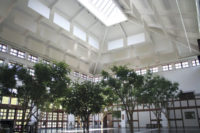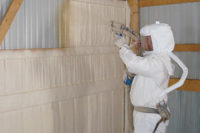How to Soundproof
















Foam does not stop sound from going through walls or ceilings.
I thought I should just go ahead and get that out of the way. It is used to stop echoes in a room. The reason you see it in soundproofed recording studios is
because they have already done things to the walls to block the sound from going through, then lined them with foam to stop the echo. So stopping echo is important but if your only concern is your neighbor not hearing your subwoofer through the wall, foam is not going to do anything at all. It is the wrong tool for the wrong job. Also, bass traps may sound like a device that traps all the bass from leaving a room, but they do not. They stop standing waves, which add a warbling noise to the bass within the room—kind of the same situation.
What stops sound then? Heavy things. Layers of heavy things that are air tight and dampened so they do not vibrate, or are made to be floppy in the first place so they will never vibrate, covering 100 percent of a wall, ceiling or floor.
Sound is simply just a vibration in a medium, whatever that medium is. If sound is transmitting through air, it has to vibrate a wall, and induce a vibration in the air on the other side of the wall, that is how the sound is getting “through” the wall. My job here is to explain what tricks of physics we can use to keep walls from inducing vibration in the air on the other side of the wall.
Here are a couple of analogies:
-
If you have a bright flashlight and put a piece of tissue paper in front of it, what happens? You see about the same amount of light intensity through the tissue paper. The tissue paper does not have enough mass to stop the light waves. This is like putting foam in front of a speaker—sound shoots right through. If you put a piece of construction paper over the flashlight, you may see some light, but less. Put two layers of paper and you see even less, then for grins put a small air gap between the layers of paper, you will see no light at all. Sound works the same way.
-
Physics recap: mass stops wave energy. If you increase mass, you decrease wave energy propagation. Layers of separated mass stop more wave energy propagation than would an equal mass of one layer.
-
A common complaint I hear from customers is, “I’m trying to stop the sound coming through my ceiling. I can hear them walking around and it’s driving me nuts!” Two kids with soup cans attached by a line string the cans across the street to each others’ houses. One kid talks into the can, the other kid can hear his voice in the other can. This is called mechanical borne sound. Remember that sound is just vibrations in a medium, and string is denser than air and will more efficiently transmit the sound over a greater distance.
FEEL THE NOISE?
The aforementioned customer’s problem is that the surface that their neighbor is walking on is mechanically connected to the drywall that makes up their ceiling because everything is tightly screwed to the floor joists, and/or glued tight to a concrete slab. All those mechanical connections are the string between the two soup cans in the analogy. We have to “cut the string” to stop the noise.
The most effective way to do this is at the floor level upstairs. Use a squishy floor underlayment under the surface they are walking on like IsoStep. The benefit here, and why it’s more effective than treating the ceiling down below, is because you are arresting the vibrations before they have a chance to work their way into any of the other building structures. Anything we do to the above floor is going to be restraining the sound from flanking down around the ceiling into the walls and whatever else in the building we do not anticipate.
That is not to say treating the ceiling is ineffective, just harder to do. We need isolation clips and two layers of drywall with a damping compound between them like Green Glue to hang from the floor joists or the concrete slab, in effect making a “floating ceiling.”
The isolation clips are effectively “cutting the string” between what is being walked on upstairs, and what makes up your ceiling. Now your ceiling has more mass and a layer of damping compound between it. The damping compound is keeping the layers of sheet rock from vibrating.
Sound is nothing more than vibration in a medium. In this example, we have broken the mechanical connection, added mass, and dampened the mass. The ability for the sound upstairs to induce a vibration in the air on the other side of the ceiling is severely mitigated.
Another common complaint is, “I want to add canned recessed lighting into my soundproof ceiling.”
No you don’t. You will shoot yourself in the foot by doing that. There is no real way to get around this as of yet, because recessed light manufacturers thus far that I know of don’t want to risk adding enough mass and air tightness to the backs of their light assemblies for them to be soundproof. Why not? Because it would be a major fire hazard. Heat would build up in that little cavity with nowhere to go, and that is bad. This is also bad for your soundproofing because a 1 percent gap in a sound barrier will transmit 50 percent of the sound energy through it. If you go through all the time and expense of soundproofing your ceiling then pop six or more holes in it, the whole thing is for nothing. The only thing stopping sound from coming through that recessed light is the housing, which is in most cases thin aluminum.
Can you rig something to block the sound behind it? You are taking the risk of causing a fire, and no matter how you do it, it wont be as soundproof had you just given up on the idea of the recessed lighting in the first place. A soundproof ceiling needs to be as unbroken as possible. Full Stop.
CONCRETE BLOCK WALLS
They are not as soundproof as you think. They can be filled with sand or mortar to be made more soundproof, but if the building is completed, what you have is some 2-inch thick elastic concrete with air cavities within resonating the sound. Basically the vibrations in the air on one side can pretty easily vibrate the air on the other side of a concrete block wall.
Isolation clips are a good solution and two layers of gypsum board with Quiet Glue Pro Damping Compound between them, over 100 percent of the wall.
DOORS
Doors are tricky. Before I worked in the noise control industry, the most I thought about doors was opening and closing them. I have come to find that you can pretty much create an entire college course on doors; the ways to hang them, and the ways to soundproof them. I’m going to try to make this as succinct as possible. Doors are the weak link in a wall, they are where sound has that 1 percent gap to try and travel through. To soundproof a door, you have to increase the mass of the door and make it airtight. That’s about it.
The frame is another matter, if it’s a hollow metal frame it needs to be packed with mineral wool, installed, and then caulked at the drywall returns. Real deal pedigreed soundproof doors are going to be in the sound transmission class 50 and STC 55 range, meaning they stop 50 dB (decibels) and 55 dB, respectively. These are expensive (roughly $3,000 to $4,000). If that’s what you need and have the budget, then it is what it is. If you don’t have that much sound to stop or it is not critical enough to justify the expense, you can just swap out your door for a solid-wood-core door, purchased locally, and install a door seal kit.
I have tried many times to verbally explain door seal kits, and for such a simple thing, it is very hard to describe to someone who has never seen one. I have made a video that I recommend watching. Find the channel Acoustical Solutions on www.Youtube.com and you will be able to view the video, entitled Acoustic Door Seal Kits.
As you can see, sound blocking is something of a rabbit hole that is easy to get lost in. I am usually pretty brief in my articles and discussions about acoustics but soundproofing is not easy and requires a lot of hard-nosed examination of the situation at hand.
Looking for a reprint of this article?
From high-res PDFs to custom plaques, order your copy today!













